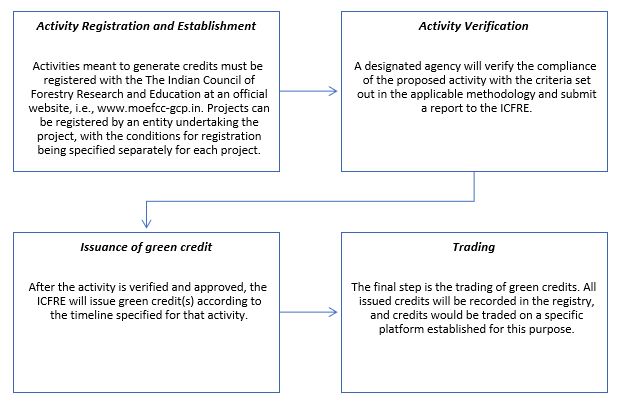Introduction
On October 13, 2023, the Indian Government established the Green Credit Programme (Programme), a market-based mechanism to reward certain environmentally friendly activities through the generation of 'Green Credits'.1 The Programme is intended to serve as a component of the broader initiative to promote the 'LiFE' - 'Lifestyle for Environment' movement, announced by the Honorable Prime Minister in 2021. Different activities would generate the same kind of green credits, albeit in different quantities.2 These green credits would be tradable on a designated platform.
While the modalities of the program are still in the process of notification, this note explores the key concepts of the Green Credit Programme as notified by the Indian Government till date.
Covered activities
Participation in the Programme is voluntary, and encompasses eight types of activities: 3
- Tree Plantation
- Water Management
- Sustainable Agriculture
- Waste Management
- Air Pollution Reduction
- Mangrove Conservation and Restoration
- Ecomark Label Development
- Sustainable building and infrastructure
Green credits under the Programme would be generated on the basis of the methodologies notified for different types of activities. The methodology for each activity covers eligibility criteria, the amount of credits generated, the expected timeline of projects, etc.
Of all the covered activities, the Government has notified the final methodology for tree plantation projects on February 26, 2024,4 after previously issuing draft methodologies for water harvesting5 and tree plantation projects6 in October, 2023 (discussed below).
Who will administer the Program?
The Indian Council of Forestry Research and Education (ICFRE) will be the administrator of the Programme, under the aegis of the Ministry of Environment, Forest and Climate Change. The ICFRE is tasked with formulating and implementing a variety of mechanisms within the scheme. This includes the procedures and criteria for registering projects, the methodologies for generating credits, the platforms and procedures for trading credits, the criteria for monitoring and verifying the activities registered, etc.7
How will the Programme function?
The process envisaged for generating green credits under the Programme would be as follows:

What Methodologies will be employed?
Final Methodology for Tree Plantation Projects
The notified methodology for tree plantations requires every State and Union Territory to identify degraded land parcels (such as forests with low tree densities or wastelands) of a minimum of five hectares,8 out of which land for a proposed project would be allotted by the ICFRE on an application.9 Subsequently, the applicant must provide a proposal as to how the tree plantation is to be undertaken in the identified land and make payment of a fee towards the cost of tree plantation and administrative expenses, as specified by the ICFRE.10 On the payment of the amount the ICFRE shall direct the Forest Department of the concerned State/Union Territory to carry out tree plantation in line with the management plan or working plan which shall be completed within a period of two years from the date of payment.11 Once the plantation of trees is complete, the ICFRE will verify the same and issue green credits.12
It is worth noting that the notified methodology on tree plantation projects varies significantly from the draft released by the Government in October 2023. The draft methodology required the applicant to undertake the actual plantation of trees itself and ensure maintenance of the plantation for up to 10 years.13 Credits would have been issued in a staggered manner over this period. Furthermore, applicants were required to regularly submit progress reports to the Government to monitor the status of the trees.14 However, as noted above, the final methodology requires the Forest Department to carry out the plantation of trees, with no specific requirements on the applicant for maintenance or reporting.
Draft Methodology for Water Harvesting Projects
The Indian Government has also issued a draft methodology on water harvesting projects in October 2023, which is yet to be finalized.
The draft requires applicants to identify the land to be used for the project,15 establish water conservation/harvesting structures (such as earthen ponds and poly tanks),16 maintain said structures for up to 10 years,17 and submit information on the progress of the project to the ICFRE at various intervals.18 Applicants would receive green credits in a staggered manner over a project's 10-year life cycle.19
ELP COMMENTS:
Both draft methodologies for tree plantation and water harvesting proposed individuals/companies initiating and maintaining eco-friendly projects for green credits, similar to carbon offset initiatives such as Verra's Verified Carbon Standard. However, the final methodology for tree plantation shifts responsibility to the Forest Department, with a fee requirement, diverging from the initial draft. Whether the final methodologies for water harvesting and other activities will adopt a similar approach remains uncertain. This updated approach could benefit businesses by reducing the effort and technical expertise required for carrying out tree plantation projects. It would also result in a shorter time frame for generation of credits due to the absence of a 10-year lock in period.
What are the implications for businesses?
Businesses considering participation in the program can explore opportunities in projects aimed at degraded and waste lands, as emphasized by the Government. Participation in such initiatives can be utilized as a tool for businesses to fulfil their corporate social responsibility (CSR) obligations. Such initiatives may be of particular interest to listed companies that would be subject to mandatory sustainability reporting requirements. Moreover, by participating in the green credit program, businesses can contribute to broader societal and environmental goals, such as climate change mitigation and biodiversity conservation.
Overall, the Green Credit Program presents businesses with a unique opportunity to align their economic interests with environmental stewardship. However, given that the finer details of the Programme are still being refined, it is essential for businesses to closely monitor developments in the Green Credit Program – particularly with regard to the methodologies for covered activities, credit generation formulas, and pricing mechanisms. Well-defined guidelines in these aspects will bolster transparency and predictability, ultimately encouraging increased participation and securing the program's sustained success over the long term.
Footnotes
1 Ministry of Environment, Forest and Climate Change, Notification S.O. 4458 (E) dated October 12, 2023, available at https://egazette.gov.in/WriteReadData/2023/249377.pdf. ("Green Credit Rules, 2023").
2 Rule 5, Green Credit Rules, 2023.
3 Rule 4(2), Green Credit Rules, 2023
4 Ministry of Environment, Forest and Climate Change, Notification S.O. 884(E) dated February 22, 2024, available at https://egazette.gov.in/WriteReadData/2024/252377.pdf. ("Final Methodology")
5 Ministry of Environment, Forest and Climate Change, Notification S.O. 4638(E) dated October 23, 2023, available at https://egazette.gov.in/WriteReadData/2023/249692.pdf.
6 Ministry of Environment, Forest and Climate Change, Notification S.O. 4643(E) dated October 23, 2023, available at https://egazette.gov.in/WriteReadData/2023/249754.pdf.
7 Rule 7, Green Credit Rules, 2023.
8 Paras. 1-2, Final Methodology.
9 Paras. 3-4, Final Methodology.
10 Paras. 5-6, Final Methodology.
11 Para. 7, Final Methodology.
12 Paras. 8-9, Final Methodology.
13 S.No. 4, Ministry of Environment, Forest and Climate Change, Notification S.O. 4643(E) dated October 23, 2023, available at https://egazette.gov.in/WriteReadData/2023/249754.pdf.
14 S.No. 6, Ministry of Environment, Forest and Climate Change, Notification S.O. 4643(E) dated October 23, 2023, available at https://egazette.gov.in/WriteReadData/2023/249754.pdf.
15 S.No. 3-4, Draft Water Harvesting Methodology.
16 S.No. 4, Draft Water Harvesting Methodology.
17 S.No. 5, Draft Water Harvesting Methodology.
18 S.No. 7, Draft Water Harvesting Methodology.
19 S.No. 6, Draft Water Harvesting Methodology.
The content of this article is intended to provide a general guide to the subject matter. Specialist advice should be sought about your specific circumstances.




